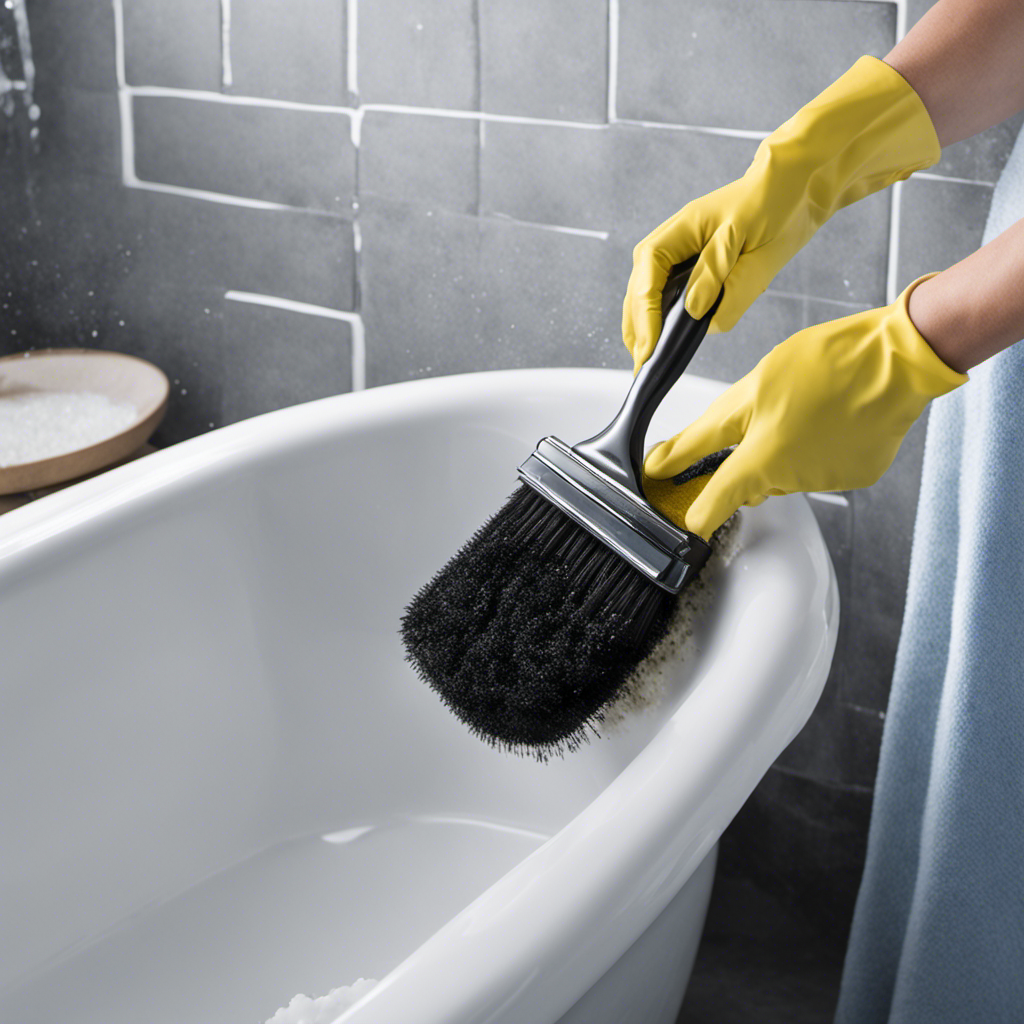Hey there, bathtub owners!
Have you ever discovered a pesky hole in your beloved fiberglass tub? Fear not, because I’ve got you covered with an easy, step-by-step guide on how to fix it.
From assessing the damage to applying the perfect patch, I’ll walk you through the entire process.
So grab your materials and let’s get started on restoring your tub to its former glory!
Key Takeaways
- Identify the size and location of the hole in the fiberglass bathtub
- Check for any surrounding damage and signs of water leakage
- Use appropriate materials and tools from a fiberglass repair kit
- Prepare the surface by sanding and cleaning before applying the patch
Assessing the Damage
Now that you’ve identified the hole, you can start assessing the damage. Fiberglass bathtub damage can occur due to a variety of causes, such as accidents, improper maintenance, or aging. It’s important to understand the extent of the damage before proceeding with any repairs.
First, carefully examine the size and location of the hole. Is it a small, hairline crack or a larger, more significant hole? Note any surrounding damage, such as chipped or discolored areas. This will help determine the best approach for repairing the hole.
Next, check for any signs of water leakage. Look for water stains or dampness around the damaged area. This will indicate if the hole has caused any water damage to the underlying structure of the bathtub.
Prevention is always better than repair, so here are some tips to prevent fiberglass bathtub holes. Avoid using abrasive cleaners or harsh chemicals that can damage the surface. Be cautious when handling heavy objects that could potentially cause impact damage. Regularly inspect the bathtub for any signs of wear and tear, and promptly address any minor issues before they escalate.
Gathering the Necessary Materials
To gather the necessary materials, you’ll need to start by checking your toolbox for items like sandpaper and epoxy resin. These are essential for repairing a hole in a fiberglass bathtub.
Here are some tips for finding the right fiberglass repair kit:
- Look for a kit specifically designed for repairing fiberglass bathtubs
- Choose a kit with a high-quality epoxy resin that will provide a strong and durable bond
- Consider the size of the hole and make sure the kit includes enough material to cover it
Now that you have your repair kit, it’s time to clean the damaged area before patching. Here’s a step-by-step guide:
- Start by removing any loose debris or pieces of fiberglass around the hole
- Use a mild detergent and warm water to clean the area, making sure to remove any soap residue
- Rinse the area thoroughly and allow it to dry completely before moving on to the next step
Cleaning the damaged area is crucial for ensuring a proper bond between the patch and the bathtub’s surface. Once the area is clean and dry, you can proceed to the next step of preparing the surface.
Preparing the Surface
To start, lightly sand the damaged area to create a rough surface for the patch to adhere to. Clean and disinfect the area around the hole using a mild soap and water solution. This ensures that the surface is free of any dirt, grime, or bacteria. Once the area is clean, use a fine-grit sandpaper to lightly sand the damaged area. This removes any loose or flaking fiberglass and creates a rough surface for the patch to bond with. Remember to sand in a circular motion with light pressure. After sanding, wipe away any dust or debris with a clean, damp cloth. Now, you’re ready to move on to the next step in repairing your fiberglass bathtub.
Applying the Patch
Once the damaged area has been sanded and cleaned, it’s time to apply the patch. Here are some tips for a seamless finish:
-
Choose the right patch material: Fiberglass repair kits are readily available, and they usually include a patch material that is compatible with fiberglass bathtubs. Make sure to follow the instructions provided.
-
Cut the patch to size: Measure the size of the hole and cut the patch material slightly larger. This will ensure that the patch covers the entire damaged area.
-
Apply the patch: Mix the resin and hardener according to the instructions. Then, using a putty knife, spread a thin layer of the mixture onto the damaged area. Place the cut patch over the resin and press it down firmly, removing any air bubbles.
Common mistakes to avoid include applying too much resin, which can cause the patch to bulge, and not pressing the patch down firmly enough, which can result in a weak bond.
With the patch in place, we can move on to finishing and testing the repair.
Finishing and Testing the Repair
Now that the patch is securely in place, it’s time to sand down any rough edges and apply a layer of finish for a smooth, polished look.
Start by using a fine-grit sandpaper to carefully sand the patched area. This will help to blend the patch with the surrounding surface and remove any imperfections. Be sure to sand in a circular motion to avoid creating visible lines.
Once the area is smooth and even, wipe away any dust or debris with a clean cloth.
Next, apply a layer of fiberglass repair gel or epoxy resin to the patched area. Use a putty knife or a small brush to spread the gel evenly, making sure to cover the entire patch. Allow the gel to dry completely according to the manufacturer’s instructions.
Lastly, it’s time for the final touches. Use a polishing compound or gel coat to give the repaired area a glossy finish. Apply the polish in a circular motion, working it into the surface until it shines.
Once the finish is dry, take a step back and admire your handiwork.
To ensure a successful repair, it’s important to test the patched area. Fill the bathtub with water and let it sit for a few hours to see if any leaks occur. If there are no leaks, congratulations! Your fiberglass bathtub is good as new.
Conclusion
Well, there you have it! Fixing a hole in a fiberglass bathtub may seem like a daunting task, but with the right materials and a little patience, it’s definitely doable.
Remember to assess the damage, gather your materials, prepare the surface, apply the patch, and finish off with testing the repair.
Coincidentally, just as you finish reading this article, you might find yourself noticing that hole in your bathtub and thinking, ‘Hey, I can fix that!’
So go ahead, give it a try!










